Camera Comparison: Google Nexus 5 vs iPhone 5s, Sony Xperia Z1, Samsung Galaxy Note 3, Galaxy S4, LG G2, Nokia Lumia 1020, HTC One
You can now read:
- Sony Xperia Z1 Compact vs Xperia Z1 vs LG G2 vs iPhone 5s vs Samsung Galaxy S4 vs HTC One Camera comparison
- HTC One (M8) vs Samsung Galaxy S4 vs Galaxy Note 3 vs iPhone 5s vs LG G2 vs Nexus 5 vs Nokia Lumia 1520 vs Sony Xperia Z1S Camera comparison
- Samsung Galaxy S5 vs HTC One (M8) vs Galaxy S4 vs iPhone 5s vs LG G2 vs Nexus 5 vs Sony Xperia Z1 Camera comparison
- Huawei Ascend P7 vs Oppo Find 7a vs Samsung Galaxy S5 vs LG G2 vs iPhone 5s vs HTC One (M8) vs Sony Xperia Z1 Camera comparison
- Sony Xperia Z2 vs Samsung Galaxy S5 vs LG G2 vs HTC One (M8) vs iPhone 5s Camera comparison

Introduction
If you’ve been keeping a close eye on our news feed, then you might have noticed that the Google Nexus 5 has been getting quite a lot of attention as of late. And that should come as no surprise since the handset is pretty great, as we concluded in our Google Nexus 5 review. What’s so special about it? Well, the smartphone has quite a lot to offer for its money – powerful hardware, polished software, and a camera that’s actually really good considering what previous Nexus-branded phones had to offer. It has 8 megapixels of resolution and optical image stabilization for steadier, blur-free images.
| Nexus 5 | iPhone 5s | Xperia Z1 | Galaxy Note 3 | Galaxy S4 | LG G2 | Lumia 1020 | HTC One | |
| Resolution | 8MP | 8MP | 20.7MP | 13MP | 13MP | 13MP | 41MP | 4MP |
| Sensor size | 1/3.4" | 1/3" | 1/2.3" | 1/3.06" | 1/3.06" | 1/3.06" | 1/1.5" | 1/3" |
| Aperture | F2.4 | F2.2 | F2.0 | F2.2 | F2.2 | F2.4 | F2/2 | F2.0 |
| Focal length | - | - | 27mm | 31mm | - | 29mm | 26mm | 28mm |
| Flash | Single LED | Dual LED | Single LED | Single LED | Single LED | Single LED | Xenon, Single LED | Single LED |
| Features | Optical image stabilization, HDR, Panorama, Scenes | Digital image stabilization, HDR, Panorama, Effects | Digital image stabilization, HDR, Panorama, Scenes, Effects | Digital image stabilization, HDR, Panorama, Scenes, Effects | Digital image stabilization, HDR, Panorama, Scenes, Effects | Optical image stabilization, HDR, Panorama, Scenes, Effects | Optical image stabilization, Panorama, Scenes, Effects | Optical image stabilization, HDR, Panorama, Scenes, Effects |
| Video | 1920x1080 30fps | 1920x1080 30fps | 1920x1080 30 fps | 1920x1080 30/60 fps 3840x2160 30 fps | 1920x1080 30 fps | 1920x1080 30/60 fps | 1920x1080 30 fps 3x zoom | 1920x1080 30 fps HDR |
Details
While not the best in the details category, the Google Nexus 5 delivers commendable results, with plenty of fine elements preserved well in its photos. At the same time, digital noise is generally absent or unnoticeable in areas that aren't of a solid color. But most of the smartphones we're testing can do an even better job at it. The Nokia Lumia 1020, in particular, is the clear winner when it comes to detail preservation. Examining its high-resolution photos at 100% zoom reveals tons of details, including ones you might have missed at the time of composing the image. In second place we rank the Sony Xperia Z1, which can also take photos of impressively high detail for a smartphone. However, its photos aren't quite as great as we expected them to be considering the 20MP resolution of its sensor. That's because when we zoom in we can easily see how finer details are destroyed by digital artifacts. But don't get us wrong, the Z1's photos are still quite pleasant to look at. It is just that the Samsung Galaxy S4, Galaxy Note 3, and the LG G2 can produce photos of almost comparable quality despite having 7 megapixels less to work with. As for the iPhone 5s, its images are neither too sharp nor too soft, and about as detailed as those produced by the Nexus 5. Trailing far behind is the HTC One, which takes the least detailed photos with its 4MP UltraPixel camera. Sure, they do look worthy of being printed in a small size or posted on a Facebook wall, but that's about as far as its camera can go. Obviously, 4 UltraPixels are not more than 4 megapixels when it comes to resolved detail.
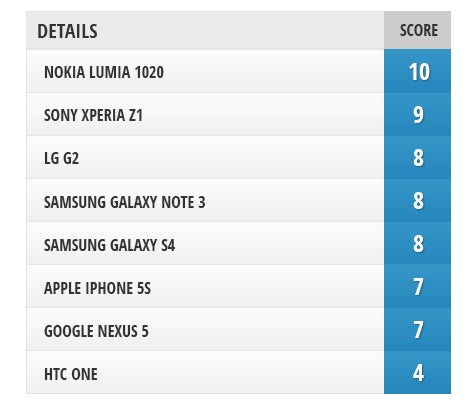
Color reproduction
A phenomenon we often observe during smartphone camera testing is the slight (or not so slight) color saturation boost introduced by the device's software. It can be seen on the photos by the Nexus 5 as well, causing them to appear a tad unnatural, but eye-catching at the same time. We'd also describe the handset's photos as a bit warmer than they should be, with slight yellowish tint, but still pleasing to the eye. Similarly, the iPhone 5s and the Nokia Lumia 1020 tend to increase the color vibrancy in their photos by a notch. The LG G2, on the other hand, often produced photos with slightly colder tones during our testing. As for the Xperia Z1, its images are mostly neutral when it comes to color representation. Not all of its shots are perfect, but for the most part, we see no shifting of hues towards the warmer or colder side, while color saturation is kept at a neutral level, just as it should be. The HTC One also performs rather balanced (neither cold nor warm looking), but its colors are rather dull and its images are often underexposed, resulting in a darker than real-life look. Overall, the Samsung Galaxy S4 and the Samsung Galaxy Note 3 delivered the best-looking colors during our shoot-out – neither too dull, nor too vivid, without any excessive cranking of their saturation. What's more, they can capture a pretty, colorful shot even in tricky lighting conditions.
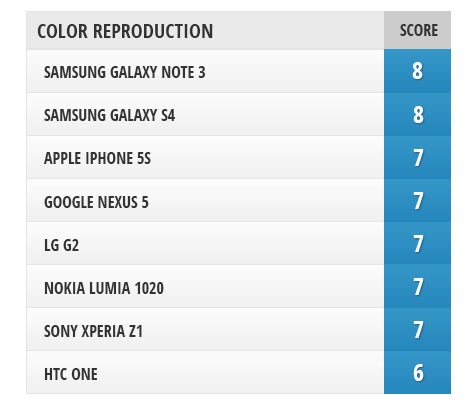
Indoor
Well, what do you know: the camera on the Google Nexus 5 is usable indoors as well. The good news is that even when the lights are dim, the Nexus 5 will capture a presentable shot. The optical stabilization allow it to shoot at slow speeds, while avoiding blur due to hand shake – this results in pics that are sharp, yet featuring good detail and low noise. However, the winner in this category is the Lumia 1020. Having a xenon flash does help when taking low-light photos, which is why we're not surprised to see that the Nokia's finest cameraphone takes the best indoor shots. But even if its flash isn't in use, its images still look outstanding – clear, detailed, and with only slight traces of digital noise, thanks to the huge sensor. Second place belongs to the Sony Xperia Z1. Sure, its low light images are noisy and have more pronounced artifacts, but its camera's high resolution makes up for that flaw. Also, the Xperia Z1 is good at retaining color accuracy when its flash has fired. After it come the Samsung Galaxy Note 3 and the Samsung Galaxy S4, which will manage to capture a good photo given a strong enough light source. But color accuracy might suffer in some scenes where their LED flash is used. The LG G2 is about as good of a performer as Samsung's finest and its LED light proves powerful enough to illuminate the scene from a fair distance. But results might be disappointing in case the lights are dim and the G2 chooses to increase its exposure time instead of firing its flash. As for the iPhone 5s, its indoor photos look great in general despite the presence of digital noise and its LED light does preserve color accuracy quite well. The HTC One produces usable photos, but not on par with the rest - we're underwhelmed by their dull, cold colors and very poor details.
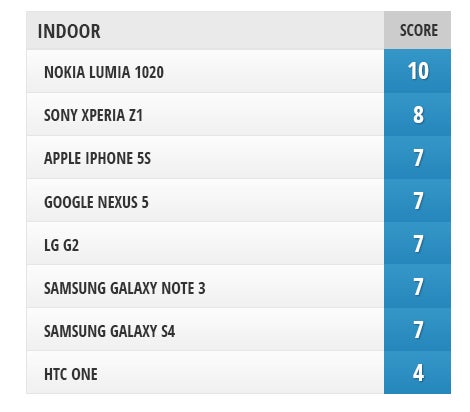
Night
Even at night, or in scenes where light is very scarce, the camera on the Google Nexus 5 can be more than usable. We won't call it the best one out there, but it definitely does get the job done. Well-illuminated scenes look quite good, with tolerable amounts of digital noise and no motion blur caused by shaky hands. However, the LG G2 is better at taking night photos. Its night images are detailed, blur-free, and with pretty accurate color representation. The iPhone 5s, the Samsung Galaxy Note 3, and the Samsung Galaxy S4 are almost as potent, especially when the last two have their night modes enabled. This time around, the Nokia Lumia 1020 did not impress us with its night-time photos since they turned out overly warm in several scenes; still, they have a very good detail level. Surprisingly, the night shots produced by the Sony Xperia Z1 are mediocre, with poor details due to the noise and artifacts. But worst of them all was... you guessed it, the HTC One – its low light images lack detail and their colors are quite messed up in certain scenes.
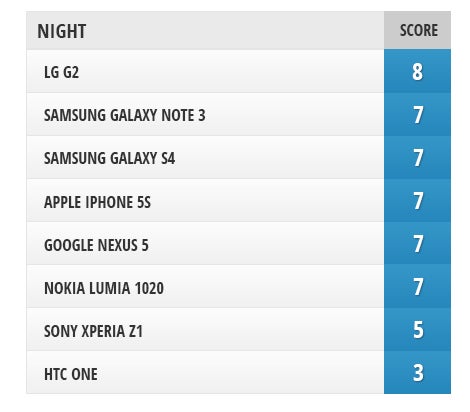
Panorama
Panorama is a fancy mode made possible by the intelligent software pre-loaded on these smartphones. Simply put, the user swipes the phone horizontally while its camera snaps photo after photo. These images are then stitched together, producing a single panoramic photograph. Don't expect Panorama mode to work equally well on all phones. In fact, some handsets are pretty bad at it, while others can deliver impressive results.
It may be rather surprising, but out of the 8 phones we compare, only 4 produce really good panoramas: the Samsung Galaxy Note 3 and S4, the iPhone 5s and the Lumia 1020. Their output files are really high-resolution ones (about 10,000 px wide), which allows them to reproduce a really good amount of detail. They also don't have any significant problems with exposure, colors or stitching the images in a nice, artifact-free manner. We have to note that the Lumia 1020 software is easiest to use, but as the phone is in landscape orientation, the panorama is rather narrow. The other three require you to hold the phone in portrait orientation and slowly pan it, which requires some user attention, but allows them to capture a bigger portion of the scene's height.
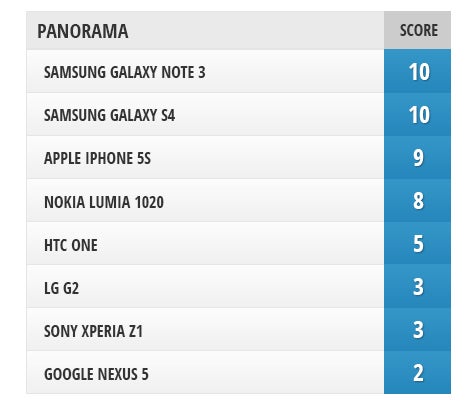
Video
All of the phones we're comparing can take 1080p high-definition videos with their main cameras. The results, however, may vary in quality as some of these handsets are more fitting for the job than others. The Google Nexus 5, in particular, performs well during the day. Its camera shoots smooth, optically stabilized 1080p video with sound of good quality. When light is low, detail presence in the frame is reduced dramatically, but the smoothness of the footage is retained at a decent level. Even better video that is richer in details can be expected from the Samsung Galaxy Note 3. We like having the option to take 1080p videos at 60 frames per second as that makes them extra fluid and even more enjoyable. Even at night, the Note 3 can easily capture footage that is smooth and detailed. Nothing short of great videos can be expected from the iPhone 5s as well, and you might be surprised by its superb software image stabilization techniques that do wonders even at night. The Sony Xperia Z1 and the Samsung Galaxy S4 perform equally well and their cameras can record videos of very high quality both during the day and at night. We’re impressed by the quality of the daytime videos shot with the Nokia Lumia 1020, but its video camera’s night performance is quite poor, resulting in videos plagued by tons of digital noise. Similarly, the LG G2 excels during the day with its smooth, 60fps video and optical image stabilization, but when light is low, there’s way too much motion blurriness present in the frame. Oh, and it videos sound overly digitized and artificial. As for the HTC One, it is an average performer. Its night videos lack smoothness and the camera software has a hard time keeping the focus in place.
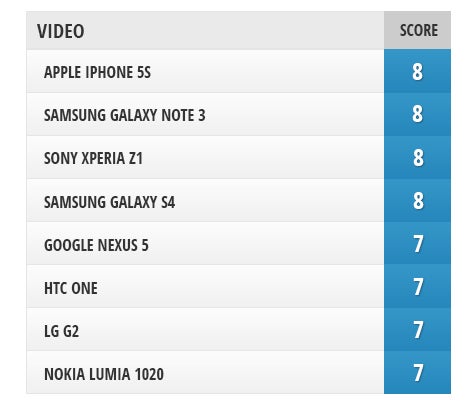
Camera interface and ease of use
Having a great camera on your phone isn't the only requirement for taking high-quality pictures. In addition to that, a lot of thought has to be put into developing a versatile camera app and an easy-to-use interface.
The camera app and UI found on the Google Nexus 5 leave us with mixed feelings about them. On one hand, we like how clean and uncluttered it is, but on the other, we find it organized poorly, with settings that are not as easy to get to as they should be. On the other hand, we like the fancy PhotoSphere mode that comes standard with it, and the lock screen shortcut is nice having.
The iPhone 5s isn't very generous on camera settings. In fact, there's very little one can adjust manually. However, the interface is extremely easy to use and can be accessed in a blink of an eye via the dedicated lock screen shortcut. What’s more, the camera is extremely rapid and requires minimal time between individual shots. For those who are into these, image filters can be applied to the photo. Special modes include HDR, which works surprisingly fast, and 120fps slow-motion videos. The handset itself is very comfortable to hold and its volume button can be used as a shutter key.
Using the Sony Xperia Z1 to take photos and videos with is a pretty straightforward process. First of all, the shape of the handset is ideal for the purpose and the dedicated 2-stage camera button allows us to instantly launch the camera app straight from the lock screen. The interface itself is set to its Intelligent Auto mode by default, adjusting the scene settings for you as best as it can. To get the most of the Z1's camera, however, you'll have to use the manual mode instead, where there are more settings to be tweaked. Sony has not forgotten to throw in a handful of awesome features as well. For example, you can stream video straight to your Facebook wall or add augmented reality effects to your shot.
Designed from the ground up with photography in mind, the Nokia Lumia 1020 is easy to hold in landscape orientation and its 2-stage button is very convenient to use. There are two camera apps loaded out of the box, namely Nokia Smart Cam and Nokia Pro Cam, and regardless of which one you choose to use, the camera's optical image stabilization will be live and running. The Smart Cam app is for casual users, allowing them to easily apply advanced manipulations to the image, such as to remove moving objects or to create dramatic action shots with motion blur and all. Those who are really into manual controls will appreciate having the Pro Cam app, which gives control over the camera's exposure, white balance and ISO speed. Even the focus and shutter speed can be adjusted manually – something most other phones will not let you do. Additional camera features, effects and filters (referred to as “camera lens”) can be downloaded from the Marketplace.
To no surprise, the Samsung Galaxy S4 and the Samsung Galaxy Note 3 share the same UI. A whole ton of shooting scenes and modes are available for the user to play with, and most of them can actually be quite useful given the appropriate conditions. We find it convenient that two separate shutters have been added – one for taking photos and another for recording videos – so there is no need to switch manually between modes as the case is with the Z1 and the G2. Both come with software image stabilization, eliminating (to some extent) the effects of vibrations introduced by the user's hand. A solid advantage for the Note 3 is that it has the option to record extra-smooth 1080p video at twice the normal framerate – 60fps. Support for 4K videos is present as well, and that footage would look nice on one of those new, fancy 4K TVs.
There is no shortage of shooting scenes, modes, and options on the HTC One. It can take HDR photos and videos at 1080p resolution, 60 frame-per-second videos at 720p, all the while capturing stereo sound of fantastic quality. However, the UI hasn't been organized the best way possible. Most settings and adjustments are placed in a single list with lots of sub-menus, so getting to the one you need may take more steps than it should. Thankfully, the frequently used ones are placed on the very top of the list.
On the LG G2 we have a well-arranged user interface with lots of shooting scenes for photos and live effects for videos. The best thing about the smartphone's camera is that it features optical image stabilization, and it works pretty well, as our experience shows. Another awesome perk is the option to shoot video at 60 fps, and the improvement in quality is easy to notice.
Conclusion
All the previous Nexus-branded smartphones were great devices as a whole, but failed to impress with the quality of their cameras. The Google Nexus 5, however, turns out to be quite different in that respect. As our testing goes to show, its 8MP optically stabilized camera can capture very detailed and good-looking images – images that are good enough to rival even the best guys in the camera department.
To no surprise, the Nokia Lumia 1020 is the undisputed leader of cameraphones thanks to its big 41MP sensor and xenon flash. Even though its rivals are steadily catching up, it will take quite a lot of effort to produce something that will outperform Nokia's high-end snapper. Still, even the Lumia 1020 could have been better, if it had better color reproduction.
The Samsung Galaxy Note 3 and the Samsung Galaxy S4, with their 13MP cameras, are both great performers overall. They take some the best smartphone photos and videos we've ever feasted our eyes on and they get the job done well in any conditions, be it when we're shooting during the day, at night, or indoors. The rich set of modes and settings offered by their camera software enhances the experience even further. We should also note that they deliver the best panoramas.
The iPhone 5s with its 8MP snapper is definitely the simplest to use for taking photos and videos. You just point, shoot, and enjoy! And the results are almost always great, which makes the camera on the iPhone 5s suitable for the needs of the great majority of consumers. Its panoramas are also of great quality.
The HTC One can't do much to impress us with. Sure, its photos do look okay in small size and its videos have excellent sound in them, but as a whole, we're not amazed by its 4MP “UltraPixel” camera. The images it produces are good enough for using on social networks or for making small prints, but if you're really serious about mobile photography, better look elsewhere.
Disclaimer: The overall score for each phone represents its average rating, but note that we're only taking into account the Details, Color representation and Indoor categories in the Overall score. We're factoring all the others (such as Night and Panorama) out, since those represent situations where users are less likely to take images in. Video recording isn't included as well, since we consider it a separate thing from photo-taking. We've done this in order to end up with an Overall rating that is representative of a camera's performance in those areas, which we think are most important to users. It's not an ultimate rating, though, so if you're particularly interested in a specific area, such as Panorama, or Video, just check out the devices' ratings in that category!
Software versions of the smartphone units used in the comparison:
Google Nexus 5 – Android 4.4 – Build KRT16M
iPhone 5s - iOS 7.0.3 (11B511)
Sony Xperia Z1 - 4.2.2 Build 14.1.G.2.257
LG G2 - Android 4.2.2 - SW version D80210a-EUR-XX
Samsung Galaxy Note 3 - Android 4.3 - Build JSS15J.N9005XXUBMI7
Samsung Galaxy S4 - Android 4.2.2 - Build JDQ39.I9505XXUAMDM
Nokia Lumia 1020 - WP8 8.0.10328.78 - Firmware 3049.0000.1330.1001
HTC One - Android 4.2.2 - Software 2.24.707.1
You can now read:
- Sony Xperia Z1 Compact vs Xperia Z1 vs LG G2 vs iPhone 5s vs Samsung Galaxy S4 vs HTC One Camera comparison
- HTC One (M8) vs Samsung Galaxy S4 vs Galaxy Note 3 vs iPhone 5s vs LG G2 vs Nexus 5 vs Nokia Lumia 1520 vs Sony Xperia Z1S Camera comparison
- Samsung Galaxy S5 vs HTC One (M8) vs Galaxy S4 vs iPhone 5s vs LG G2 vs Nexus 5 vs Sony Xperia Z1 Camera comparison
- Huawei Ascend P7 vs Oppo Find 7a vs Samsung Galaxy S5 vs LG G2 vs iPhone 5s vs HTC One (M8) vs Sony Xperia Z1 Camera comparison
- Sony Xperia Z2 vs Samsung Galaxy S5 vs LG G2 vs HTC One (M8) vs iPhone 5s Camera comparison
Follow us on Google News

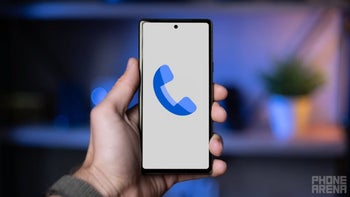

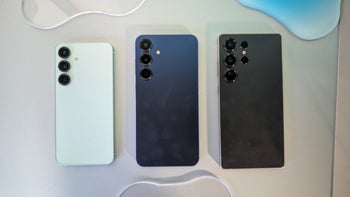
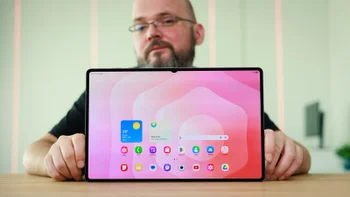
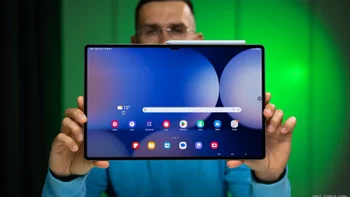

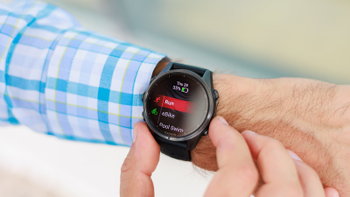

Things that are NOT allowed:
To help keep our community safe and free from spam, we apply temporary limits to newly created accounts: